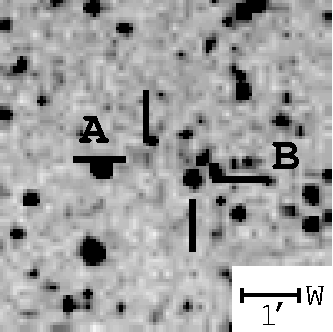Home Page Updated on June 25, 2002
Influence of MisV0701 to a planetary nebula PK 32-3.1March 10, 2000Yoshida, S.; Kadota, K.; Kato, T.; Richmond, M. This report discusses on a new variable star MisV0701 near by a planetary nebula PK 32-3.1 and the influence to the analysis of the planetary nebula. In the course of the MISAO Project variable star survey, the variability of USNO-A2.0 0825.14008002, R.A. 19h00m31s.767, Decl. -02o12'20".35 (2000.0), 14.7 mag(R), 19.3 mag(B), was discovered from unfiltered CCD images taken by Kadota, with a brightness variation between 13.0 - 14.8 mag between 1999 April and July and named as MisV0701. MisV0701 is within 1 arcmin from a planetary nebula PK 32-3.1 (Perek and Kohoutek 1967). But the chart of PK 32-3.1 assures that MisV0701 is evidently separated from the nebula.
A: PK 32-3.1 B: MisV0701 Table 1 shows the photometry of MisV0701 based on the unfiltered CCD observations by Kadota and the I-band CCD observations by TASS (The Amateur Sky Survey) project. Although the magnitude system is different, the data show the slow variability. MisV0701 was too faint to measure in V-band in the TASS images, which means the V-I is greater than 3 mag. The color in the USNO-A2.0 catalog also implies that the star is reddish. Therefore, MisV0701 is a red variable star, probably semiregular or Mira type. Table 1: Photometry of MisV0701
The small angular distance between MisV0701 and PK 32-3.1 can cause mixture of the characteristics in data analysis. Stenholm and Acker suggested that PK 32-3.1 is one of the misclassified planetary nebulae based on the spectrum (Stenholm and Acker 1987). MacConnell also suggested that PK 32-3.1 is probably not a planetary nebula because the spectral type is Me (MacConnell 1983). However, the Me type spectrum is typical for a red variable star. Therefore, their spectrum can be explained by the confusion with the red variable star MisV0701. PK 32-3.1 is identified with IRAS 18579-0216, R.A. 19h00m34s.05, Decl. -02o12'01".7 (2000.0), with fluxes 3.98 Jy for 12 micron, 15.99 Jy for 25 micron, 7.45 Jy for 60 micron and the upper limit of 83.72 Jy for 100 micron. A red variable star as bright as MisV0701 can be detected by the IRAS, however, there is no independent entry in the IRAS Point Source Catalog for MisV0701. But considering to the small angular distance as 39 arcsec between MisV0701 and IRAS 18579-0216, and the positional error of IRAS 18579-0216 as 19 x 6 arcsec (position angle is 81 deg), the fluxes for IRAS 18579-0216 can be regarded as a combination of the planetary nebula PK 32-3.1 and MisV0701. The location of IRAS 18579-0216 on the IRAS two-color diagram (Zijlstra et al. 1990; Van der Veen and Habing 1988) is not inconsistent with the classification as a planetary nebula. However, the location is closer to the border between planetary nebulae and OH/IR stars, which may be explained by the contribution from MisV0701. Attention should be paid in interpreting the IRAS fluxes and colors of PK 32-3.1. References
Supplement Daisaku Nogami comments that the 1 arcmin distance between MisV0701 and PK 32-3.1 is too large to influence the spectrum, and the strange spectrum in MacConnell 1983 is due to some mistake, maybe he observed a wrong object for instance. It is also pointed out that PK 32-3.1 is given as a planetary nebula without question in the Strasbourg-ESO catalogue. |

